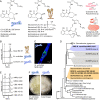Bacterial endosymbionts protect beneficial soil fungus from nematode attack
- PMID: 34504005
- PMCID: PMC8449335
- DOI: 10.1073/pnas.2110669118
Bacterial endosymbionts protect beneficial soil fungus from nematode attack
Abstract
Fungi of the genus Mortierella occur ubiquitously in soils where they play pivotal roles in carbon cycling, xenobiont degradation, and promoting plant growth. These important fungi are, however, threatened by micropredators such as fungivorous nematodes, and yet little is known about their protective tactics. We report that Mortierella verticillata NRRL 6337 harbors a bacterial endosymbiont that efficiently shields its host from nematode attacks with anthelmintic metabolites. Microscopic investigation and 16S ribosomal DNA analysis revealed that a previously overlooked bacterial symbiont belonging to the genus Mycoavidus dwells in M. verticillata hyphae. Metabolic profiling of the wild-type fungus and a symbiont-free strain obtained by antibiotic treatment as well as genome analyses revealed that highly cytotoxic macrolactones (CJ-12,950 and CJ-13,357, syn necroxime C and D), initially thought to be metabolites of the soil-inhabiting fungus, are actually biosynthesized by the endosymbiont. According to comparative genomics, the symbiont belongs to a new species (Candidatus Mycoavidus necroximicus) with 12% of its 2.2 Mb genome dedicated to natural product biosynthesis, including the modular polyketide-nonribosomal peptide synthetase for necroxime assembly. Using Caenorhabditis elegans and the fungivorous nematode Aphelenchus avenae as test strains, we show that necroximes exert highly potent anthelmintic activities. Effective host protection was demonstrated in cocultures of nematodes with symbiotic and chemically complemented aposymbiotic fungal strains. Image analysis and mathematical quantification of nematode movement enabled evaluation of the potency. Our work describes a relevant role for endofungal bacteria in protecting fungi against mycophagous nematodes.
Keywords: microbial interactions; natural products; symbiosis.
Copyright © 2021 the Author(s). Published by PNAS.
Conflict of interest statement
The authors declare no competing interest.
Figures



References
-
- Fierer N., Embracing the unknown: Disentangling the complexities of the soil microbiome. Nat. Rev. Microbiol. 15, 579–590 (2017). - PubMed
-
- Bardgett R. D., van der Putten W. H., Belowground biodiversity and ecosystem functioning. Nature 515, 505–511 (2014). - PubMed
-
- Tedersoo L., et al. ., Fungal biogeography. Global diversity and geography of soil fungi. Science 346, 1256688 (2014). - PubMed
Publication types
MeSH terms
Substances
Supplementary concepts
Grants and funding
LinkOut - more resources
Full Text Sources
Other Literature Sources
Molecular Biology Databases
Miscellaneous

